Tonaya
Hacienda de Coatlancillo
This hacienda is located east of Coatlancillo, and grew sugar cane, corn and beans. It had a steam mill for processing the sugar cane and produced loose sugar, sugar loaves and a distilled spirit called cazacha.
Ignacio Cisneros Vázquez was from Sayula. He owned Coatlancillo and its surroundings and lived at the hacienda.
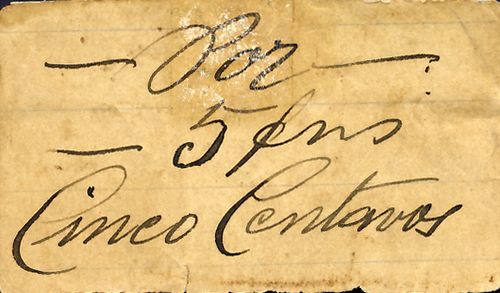
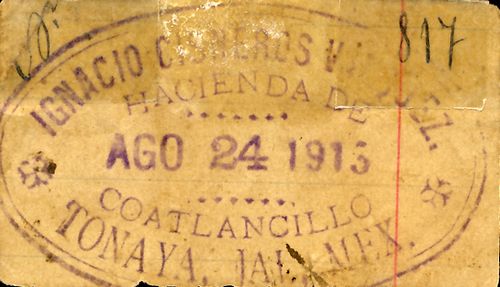 M2736 5c Hacienda de Coatlancillo
M2736 5c Hacienda de Coatlancillo
| date on note | from | to | total number |
total value |
||
| 5c | 24 August 1915 | includes number 817 |
Hacienda El Refugio
It is unclear whether Manuel Vergara and Adofo Ochoa ran the hacienda "El Refugio" or a local store. Adolfo Ochoa was reported in charge of the hacienda del Refugio, in the municipio de San Gabriel, in July 1913El Diario, 29 July 1913.
Series 1
The hacienda issued notes drawn on Vergara y Ochoa with revenue stamps on the reverse.
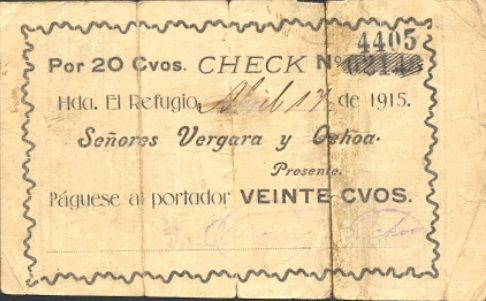 M2728 20c Hacienda El Refugio
M2728 20c Hacienda El Refugio
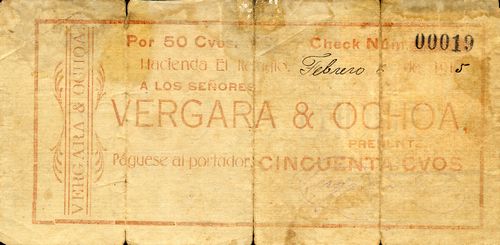
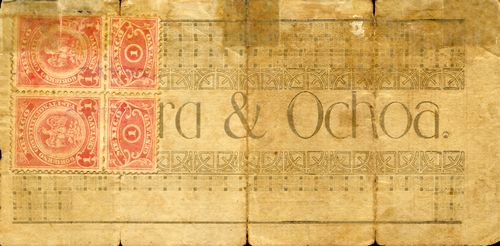 M2730 50c Hacienda El Refugio
M2730 50c Hacienda El Refugio
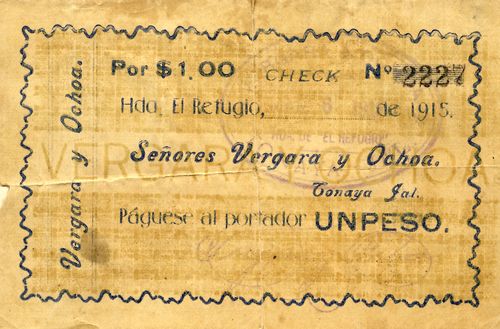 M2733a $1 Hacienda El Refugio
M2733a $1 Hacienda El Refugio
| date on note | from | to | total number |
total value |
signed by | ||
| 20c | 17 April 1915 | includes number 4405CNBanxico #11411 | |||||
| 50c | 6 February 1915 | 00001 | includes number 00019 | ||||
| $1 | 12 March 1915 | Adolfo Ochoa | includes number 2645CNBanxico #4614 |
Series 2
They then issued a different series or series, without revenue stamps as they were no longer available.
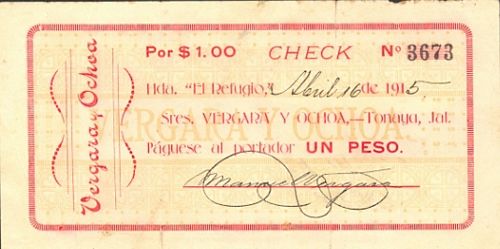
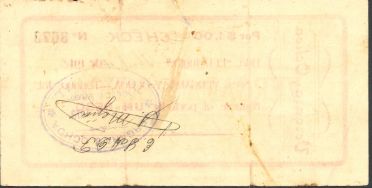 M2733b $1 Hacienda El Refugio
M2733b $1 Hacienda El Refugio
| date on note | from | to | total number |
total value |
signed by | ||
| $1 | 16 April 1915 | Manuel Vergara | includes number 3673CNBanxico #11413 |
Dick Long in his November 1974 auction listed an undated "20c, number 2719, black print on light green-blue, uniface, 40x57mm". Where should this be placed?
Series 3
Finally, Vergara y Ochoa arranged for their notes to be legalised by the Agente de Timbre in Tonaya, S. Mejía. These have a certification on the reverse, referring to article 246 of the general legalisation on stamp duty (Ley de la Renta Federal del timbre) of 1 June 1906, which makes provision in the event of a lack of revenue stampsArt. 246. Si en algún lugar faltaren estampillas, el que necesite timbrar un documento ó libro lo presentará á la oficina del Timbre para que lo legalice, previo el pago del impuesto de las estampillas que debieran usarse, y poniendo una nota de legalización que autorizará el jefe de la oficina, quien expedirá al interesado una certificación de haber hecho el pago en efectivo por falta de estampillas and states that the holders of documents should present them to the oficina del Timbre and the jefe will certify that the holder has paid cash in place of the required stamps.
These notes had a variety of borders.
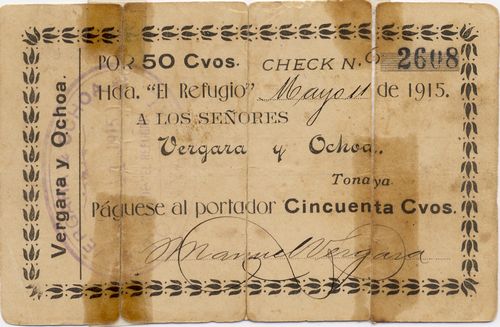
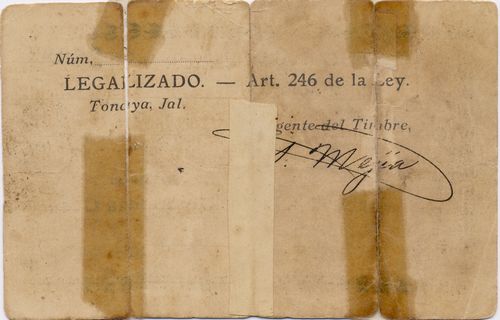
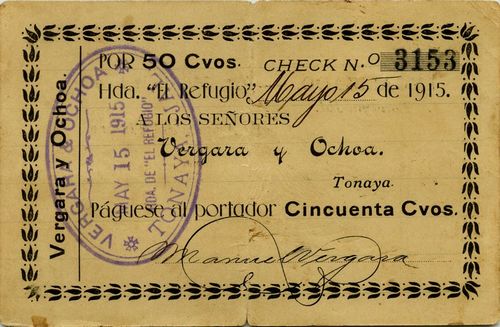
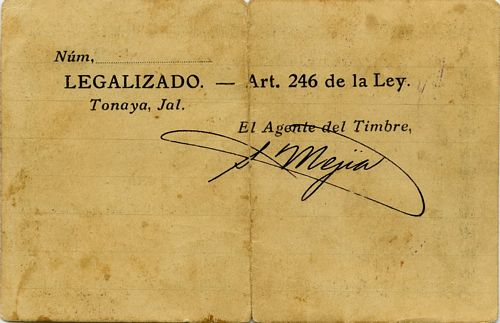
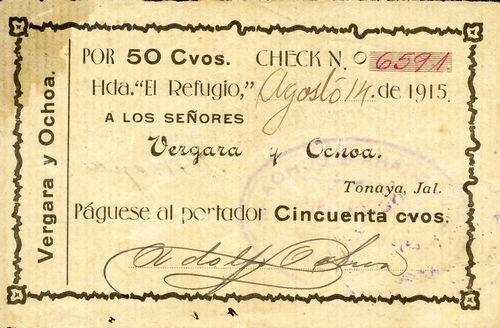
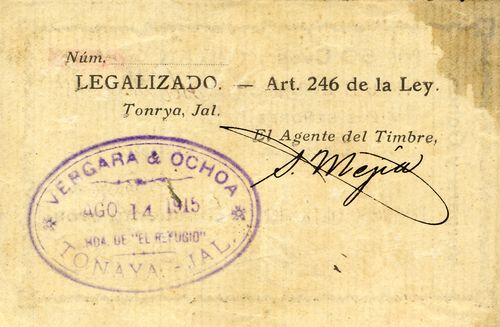 M2729 50c Hacienda El Refugio
M2729 50c Hacienda El Refugio
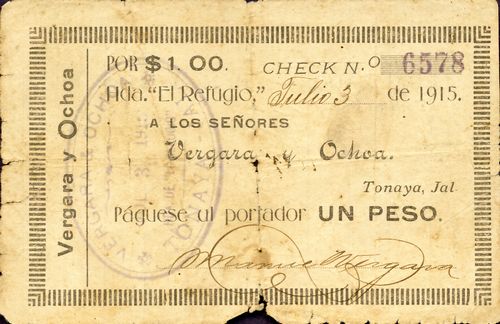
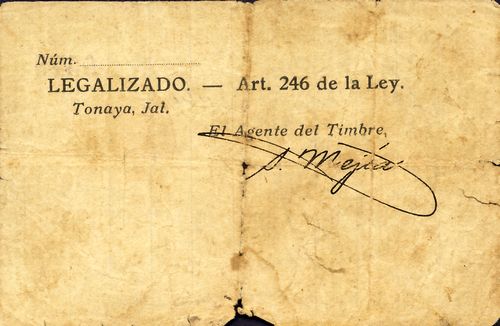
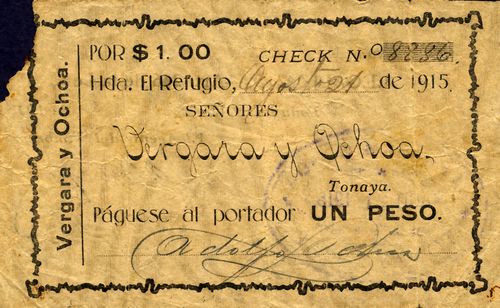
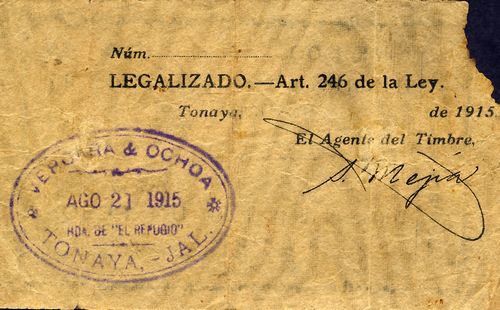 M2732 $1 Hacienda El Refugio
M2732 $1 Hacienda El Refugio
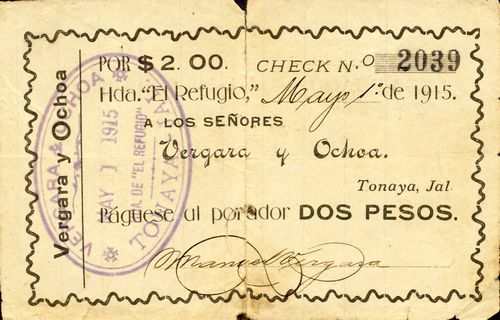
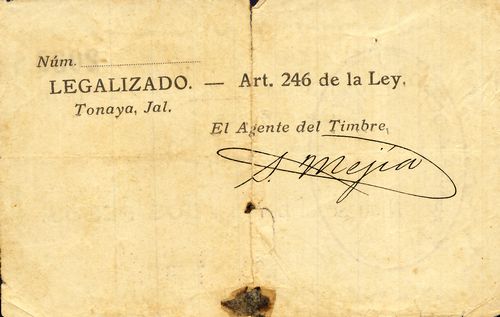 M2734 $2 Hacienda El Refugio
M2734 $2 Hacienda El Refugio
| date on note | from | to | total number |
total value |
signed by | ||
| 20c | 22 May 1915 | includes number 5479 | |||||
| 50c | 8 May 1915 | Adolfo Ochoa | includes number 2459 | ||||
| Manuel Vergara | includes number 2723CNBanxico #4610 | ||||||
| 11 May 1915 | Manuel Vergara | includes number 2608 | |||||
| 15 May 1915 | Manuel Vergara | includes numbers 3153 to 3798CNBanxico #4609 | |||||
| 22 May 1915 | Manuel Vergara | includes number 3653CNBanxico #4611 | |||||
| 26 May 1915 | includes number 4501 | ||||||
| 10 July 1915 | includes number 4691 | ||||||
| 31 July 1915 | includes number 5151 | ||||||
| 14 August 1915 | Adolfo Ochoa | includes numbers 6232CNBanxico #11412 to 6959 | |||||
| Manuel Vergara | |||||||
| $1 | 24 April 1915 | Adolfo Ochoa | includes number 4087CNBanxico #4613 | ||||
| 29 May 1915 | Adolfo Ochoa | includes numbers 5177CNBanxico #11414 to 5492 | |||||
| 5 June 1915 | includes 5531 | ||||||
| 26 June 1915 | Adolfo Ochoa | includes number 6280CNBanxico #4612 | |||||
| 3 July 1915 | Manuel Vergara | includes number 6578 | |||||
| 21 August 1915 | Adolfo Ochoa | includes number 8886 | |||||
| $2 | 1 May 1915 | Manuel Vergara | includes number 2039 | ||||
| 15 May 1915 | includes number 2961CNBanxico #11415 |
Tonila
Hacienda de San Marcos
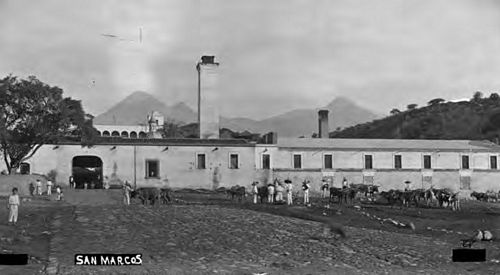
The sugarcane hacienda of San Marcos, Tonila. In the background are the Volcan de Fuego and Nevada de Colima
This was owned by Señora Concepción Palomar de Corcuera, who was the wife of Manuel L. Corcuera y Luna and a renowned socialite.
These were modelo 4667, produced in 1915 by Juan Kaiser.
 M2747 5c Hacienda de San Marcos
M2747 5c Hacienda de San Marcos
| total number |
total value |
||
| 5c | 300 | $ 15.00 | oblong brown cartón |
| 10c | 300 | 30.00 | |
| 20c | 300 | 60.00 | |
| 25c | 300 | 75.00 | |
| 50c | 500 | 250.00 | |
| 100c | 500 | 500.00 | |
| 2,200 | $930.00 |
Hacienda de la Esperanza
This hacienda was owned by Enrique Schöndube. Schöndube was born in Germany in 1861. From 1894 he established in Mexico an independent commission house that exclusively distributed the products of the Allgemeine Elektricitäts Gesellschaft factory. Machines, engines, turbines, generators, dynamos, boilers, transformers, pumps and all kinds of tools and electrical materials arrived at his warehouse from Germany and elsewhere, which he then sold or installed in theatres as well as in shops, textile factories or in local electricity generation companies.
Soon, with the capital raised in his commission agency Schöndube began to invest in other areas. From at least 1899 he obtained a concession from Guadalajara to use the Santiago River and began to invest in the generation of electricity. Between 1900 and 1901 he sought to establish an explosives factory and in this or another business he entered into competition with the French businessman Ernest Pugibet.
His career took a turn in 1905, when he partnered with Francisco Neugebauer, an Austrian engineer who had experience like few others in the field of electricity. Neugebauer had arrived in Mexico as a delegate of the Siemens & Halske company, perhaps around 1890 and the new partners brought together in-depth knowledge and relationship with the two major German electrical products companies, Siemens and AEG.
From 1906 to 1914 Schöndube expanded his interests, becoming a contractor for services such as the installation of water, drainage and paving networks. Sometimes he executed them directly (with Neugebauer while he had him as a partner), but other times acting as a speculator, or in relations of friendship, collusion and supply with the Compañía Bancaria de Fomento y Bienes Raíces and the Banco Central Mexicano.
The relationship between Schöndube and Neugebauer ended in 1911 when the latter returned to Austria. Schöndube closed the commission house a year later, left his residence in Mexico City and spent much of his time at this Hacienda La Esperanza, which he had acquired in 1909.
This hacienda used modelo 4717, produced by Juan Kaiser in March 1914.
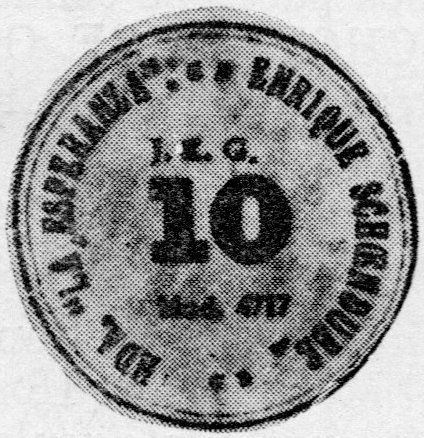 M2743 10c Hacienda de la Esperanza
M2743 10c Hacienda de la Esperanza
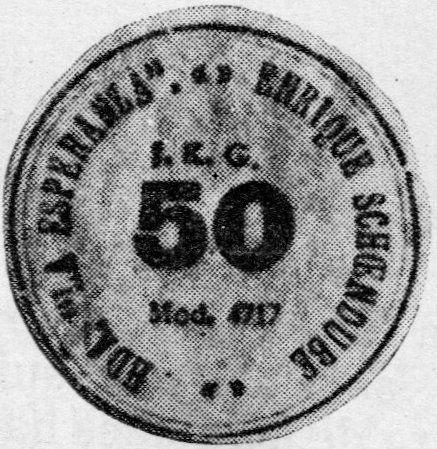 M2745 50c Hacienda de la Esperanza
M2745 50c Hacienda de la Esperanza
| total number |
total value |
||
| 5c | 1,000 | $ 50.00 | round brown cartón |
| 10c | 1,000 | 100.00 | |
| 20c | 1,000 | 200.00 | |
| 50c | 1,000 | 500.00 | |
| l | 4,000 | $850.00 |
